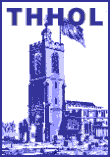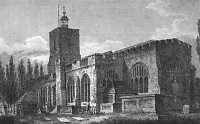 The Parish Church of Stepney, scarcely a stone's throw from the Harford Street [Gas]
Works, has undergone many restorations and suffered much from the zeal of those who
in taking the work in hand did not realise the degree of their responsibility to maintain the
appearance and constitution of the original structure. During the nineteenth century the church
extensively underwent this sort of treatment so that externally very little of the ancient stonework
remains visible. The old engravings and the modern photograph reproduced in this article will,
if compared, convey to the mind a better impression of the changes in its exterior that have
taken place in the last hundred and fifty years than can be received by a verbal description.
In 1899-1900 praiseworthy efforts were made to bring the interior to something like its earlier
state and particularly this was done by the removal of the disfiguring galleries, one of which
was first put into position as long ago as 1580 when greater accommodation had to be provided
for the increasing number of inhabitants of that part of the parish situated by the riverside.
Soon after the restoration was completed the church was threatened by a calamity. On the morning
of 12th October 1901, shortly before half-past six, it was discovered to be burning. The organ
under which the fire originated was quickly consumed, and the flames reaching the roof the edifice
seemed doomed. Fortunately the fire was got under control and by eight o'clock was extinguished.
To the old portions of the church and to the monuments little harm was done, but bare walls
only remained of the vestries, which were of modern construction. There, among the ruins, were
found to be the registers and plate uninjured in their safes. The roof of the nave was considerably
damaged, but had it escaped it would not, on account of its age and state of decay, have lasted
for many more years. It has been replaced by sound English oak, and without a catastrophe happening
it should endure for some centuries to come.
The Parish Church of Stepney, scarcely a stone's throw from the Harford Street [Gas]
Works, has undergone many restorations and suffered much from the zeal of those who
in taking the work in hand did not realise the degree of their responsibility to maintain the
appearance and constitution of the original structure. During the nineteenth century the church
extensively underwent this sort of treatment so that externally very little of the ancient stonework
remains visible. The old engravings and the modern photograph reproduced in this article will,
if compared, convey to the mind a better impression of the changes in its exterior that have
taken place in the last hundred and fifty years than can be received by a verbal description.
In 1899-1900 praiseworthy efforts were made to bring the interior to something like its earlier
state and particularly this was done by the removal of the disfiguring galleries, one of which
was first put into position as long ago as 1580 when greater accommodation had to be provided
for the increasing number of inhabitants of that part of the parish situated by the riverside.
Soon after the restoration was completed the church was threatened by a calamity. On the morning
of 12th October 1901, shortly before half-past six, it was discovered to be burning. The organ
under which the fire originated was quickly consumed, and the flames reaching the roof the edifice
seemed doomed. Fortunately the fire was got under control and by eight o'clock was extinguished.
To the old portions of the church and to the monuments little harm was done, but bare walls
only remained of the vestries, which were of modern construction. There, among the ruins, were
found to be the registers and plate uninjured in their safes. The roof of the nave was considerably
damaged, but had it escaped it would not, on account of its age and state of decay, have lasted
for many more years. It has been replaced by sound English oak, and without a catastrophe happening
it should endure for some centuries to come.
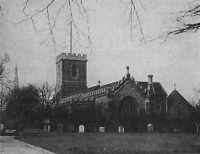 The
aspect of the church to-day, with its outward walls of ragstone rubble, limestone dressings,
and embattled ornamentation, is suggestive of complacency at the treatment it has experienced.
In 1885-6 the ground was excavated immediately about the church so that it could be entered
on the level and in order that dampness from the soil might not affect the fabric. This has
produced a moat-like effect on three sides, while from the fourth, the west, the tower is approached
by sloping ground. At the same time this peculiarity was accentuated by the iron railing which
was put up to keep the inner sunken space free from the intrusion of loiterers from the public
recreation garden that was then formed out of the old and neglected churchyard. The illustration
[above right] shows the church as it now is, and apparently
as having subsided into the ground.
The
aspect of the church to-day, with its outward walls of ragstone rubble, limestone dressings,
and embattled ornamentation, is suggestive of complacency at the treatment it has experienced.
In 1885-6 the ground was excavated immediately about the church so that it could be entered
on the level and in order that dampness from the soil might not affect the fabric. This has
produced a moat-like effect on three sides, while from the fourth, the west, the tower is approached
by sloping ground. At the same time this peculiarity was accentuated by the iron railing which
was put up to keep the inner sunken space free from the intrusion of loiterers from the public
recreation garden that was then formed out of the old and neglected churchyard. The illustration
[above right] shows the church as it now is, and apparently
as having subsided into the ground.
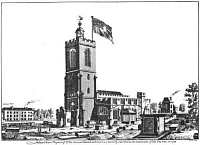 The story of the parish and its church is far too long to be told on this occasion, but some
references to its past are given to explain how they came into being.
The story of the parish and its church is far too long to be told on this occasion, but some
references to its past are given to explain how they came into being.
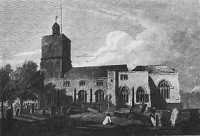 In the present edifice, which is believed to be the third erected on the spot, there is doubtless
embodied much of the material of those that previously existed but which, because of its incorporation,
cannot be identified. The earliest building arose in the far-distant period when the Danish
invaders often threatened the inhabitants of London, whose Bishop organised the defence on the
eastern side, and in consequence he became recognised as holding the lordship of that great
tract of territory that afterwards was held by him as the Manor of Stepney. It was not held
with regard to his spiritual offices but by knight service, that is, by the fulfilment of the
military obligations imposed upon him. The area of Stepney which was described as a manor for
the purposes of land tenure, was a parish for ecclesiastical affairs and a vill for civil matters
such as crime.
In the present edifice, which is believed to be the third erected on the spot, there is doubtless
embodied much of the material of those that previously existed but which, because of its incorporation,
cannot be identified. The earliest building arose in the far-distant period when the Danish
invaders often threatened the inhabitants of London, whose Bishop organised the defence on the
eastern side, and in consequence he became recognised as holding the lordship of that great
tract of territory that afterwards was held by him as the Manor of Stepney. It was not held
with regard to his spiritual offices but by knight service, that is, by the fulfilment of the
military obligations imposed upon him. The area of Stepney which was described as a manor for
the purposes of land tenure, was a parish for ecclesiastical affairs and a vill for civil matters
such as crime.
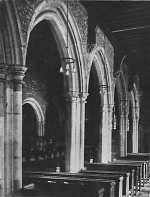 As a parish Stepney did not come into being until the twelfth century, but long before then
a chapel had been built on the track that led from the Bishop's Hall, and crossed what is now
Old Ford Road on the way down to the river. In every place the oldest road is that which leads
to the river, and this track may he taken to have followed the line of Globe Road, White Horse
Lane, round to White Horse Street to Ratcliff. Curiously enough, a part of White Horse Street
is still referred to as the Old Road. A mile south of the Bishop's Hall a little chapel was
built for the spiritual welfare of the dwellers by the waterside. To provide a suitable place
for their Christian burial a spot was necessary that was beyond the belt of marshland, and this
fact accounts for the distance it stood away from the habitations. This chapel
is said to have been dedicated originally to All Saints and subsequently to St. Dunstan after
his canonisation, which was one accepted by the Anglo-Saxon Church by popular acclamation.
This illustrious Englishman was born at Glastonbury about 925 and became Bishop of London, and
it may be presumed that he for a period lived in what was then Stepney at the Hall, the site
of which is to be located north-east of the Bethnal Green Museum [now the Museum of Childhood].
At the time of his death in 988 he was Archbishop of Canterbury, but his activities were rather
those of a teacher and organiser than those of an ecclesiastic. As the Prime Minister of his
day his influence was directed to bringing together the Saxons, Angles, and the Danes to live
in peace and to be subject to the same laws. In his private life he was devoted to music, literature
and to the art of metal working. There are many legends concerning him: one in particular, that
of tweaking the Devil's nose with red-hot tongs being the best known. Stepney should be proud
of its patron saint.
As a parish Stepney did not come into being until the twelfth century, but long before then
a chapel had been built on the track that led from the Bishop's Hall, and crossed what is now
Old Ford Road on the way down to the river. In every place the oldest road is that which leads
to the river, and this track may he taken to have followed the line of Globe Road, White Horse
Lane, round to White Horse Street to Ratcliff. Curiously enough, a part of White Horse Street
is still referred to as the Old Road. A mile south of the Bishop's Hall a little chapel was
built for the spiritual welfare of the dwellers by the waterside. To provide a suitable place
for their Christian burial a spot was necessary that was beyond the belt of marshland, and this
fact accounts for the distance it stood away from the habitations. This chapel
is said to have been dedicated originally to All Saints and subsequently to St. Dunstan after
his canonisation, which was one accepted by the Anglo-Saxon Church by popular acclamation.
This illustrious Englishman was born at Glastonbury about 925 and became Bishop of London, and
it may be presumed that he for a period lived in what was then Stepney at the Hall, the site
of which is to be located north-east of the Bethnal Green Museum [now the Museum of Childhood].
At the time of his death in 988 he was Archbishop of Canterbury, but his activities were rather
those of a teacher and organiser than those of an ecclesiastic. As the Prime Minister of his
day his influence was directed to bringing together the Saxons, Angles, and the Danes to live
in peace and to be subject to the same laws. In his private life he was devoted to music, literature
and to the art of metal working. There are many legends concerning him: one in particular, that
of tweaking the Devil's nose with red-hot tongs being the best known. Stepney should be proud
of its patron saint.
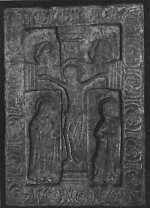 One piece of evidence that bears witness to the antiquity of the consecration of the site to
Christian worship is to be seen in the church, affixed to the chancel wall
[right], behind the pulpit near the organ. It is a rectangular
stone slab measuring 3¼ feet by 2¼ feet on which is carved within an ornamented
border a representation of the Crucifixion and the figures of the Virgin Mary and St. John.
Considering that it is over 900 years old - it was incised about the year 1000 - this fine piece
of Anglo-Saxon craftsmanship is in a remarkably good state of preservation.
One piece of evidence that bears witness to the antiquity of the consecration of the site to
Christian worship is to be seen in the church, affixed to the chancel wall
[right], behind the pulpit near the organ. It is a rectangular
stone slab measuring 3¼ feet by 2¼ feet on which is carved within an ornamented
border a representation of the Crucifixion and the figures of the Virgin Mary and St. John.
Considering that it is over 900 years old - it was incised about the year 1000 - this fine piece
of Anglo-Saxon craftsmanship is in a remarkably good state of preservation.
The interior of the present edifice is mainly of the late fifteenth century, although there are parts of it which are older. In the north aisle, for instance, the second window from the east, which is different from the others, belongs to the beginning of the fourteenth century, and on the south side of the chancel there are traces of work executed a hundred years before, that is, about the year 1250. There are in addition to these further indications of the second church that once stood here... An arch [can be seen] that is higher and more pointed than the rest. It represents the extent of the former chancel.
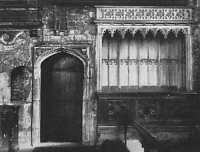 On the north side of the chancel is the large canopied altar tomb, about
seven feet wide, of Sir Henry Collet (nowadays spelt Colet) the father of John Collet, Dean
of St. Paul's. The inscription on a small brass shield states:-
On the north side of the chancel is the large canopied altar tomb, about
seven feet wide, of Sir Henry Collet (nowadays spelt Colet) the father of John Collet, Dean
of St. Paul's. The inscription on a small brass shield states:-
Here lyeth Sir Henry Collet knight twice mayor of London who died in the year of our Redemption 1510.
Sir Henry Collet built and lived in a house known as The Great Place, the grounds of which adjoin the churchyard in what is now called Spring Garden Place. The Green Dragon public house occupies the actual site of the house. He acquired an extensive estate in Stepney which passed to his son by inheritance, and was by him bequeathed in trust to the Mercers' Company of London for the foundation of St. Paul's School, now rebuilt at Hammersmith.
High up on the south wall of the chancel is the monument of Sir Thomas Spert...
The church also contains many other interesting monuments, some of which were brought down into the aisles when the galleries already referred to were demolished.
Although Stepney Church cannot claim to possess remarkable architectural features, it is one of the largest and finest of the medieval churches in the Metropolis. It is interesting for its historical appeal to the imagination of the English-speaking people here and in all parts of the world which is quickened by the memories of the close association of the parish and its church with the rise of England's maritime power and early colonial enterprise.
by Sydney Maddocks
